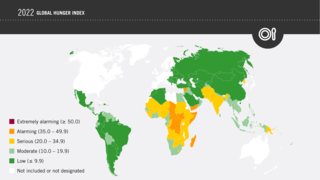Related Research Articles

Human nutrition deals with the provision of essential nutrients in food that are necessary to support human life and good health. Poor nutrition is a chronic problem often linked to poverty, food security, or a poor understanding of nutritional requirements. Malnutrition and its consequences are large contributors to deaths, physical deformities, and disabilities worldwide. Good nutrition is necessary for children to grow physically and mentally, and for normal human biological development.

In politics, humanitarian aid, and the social sciences, hunger is defined as a condition in which a person does not have the physical or financial capability to eat sufficient food to meet basic nutritional needs for a sustained period. In the field of hunger relief, the term hunger is used in a sense that goes beyond the common desire for food that all humans experience, also known as an appetite. The most extreme form of hunger, when malnutrition is widespread, and when people have started dying of starvation through lack of access to sufficient, nutritious food, leads to a declaration of famine.

Starvation is a severe deficiency in caloric energy intake, below the level needed to maintain an organism's life. It is the most extreme form of malnutrition. In humans, prolonged starvation can cause permanent organ damage and eventually, death. The term inanition refers to the symptoms and effects of starvation. Starvation may also be used as a means of torture or execution.

Malnutrition occurs when an organism gets too few or too many nutrients, resulting in health problems. Specifically, it is "a deficiency, excess, or imbalance of energy, protein and other nutrients" which adversely affects the body's tissues and form. Malnutrition is not receiving the correct amount of nutrition. Malnutrition is increasing in children under the age of five due to providers who cannot afford or do not have access to adequate nutrition.

The Mid Day Meal Scheme is a school meal programme in India designed to better the nutritional standing of school-age children nationwide. The scheme has been renamed as POSHAN Scheme. The programme supplies free lunches on working days for children in government primary and upper primary schools, government aided Anganwadis, Madarsa and Maqtabs. Serving 120 million children in over 1.27 million schools and Education Guarantee Scheme centres, the Midday Meal Scheme is the largest of its kind in the world.
BIMARU is an acronym formed from the first letters of the names of the Indian states of Bihar, Madhya Pradesh, Rajasthan, and Uttar Pradesh. It was coined by Ashish Bose in the mid-1980s. BIMARU has a resemblance to a Hindi word bīmār (बीमार) meaning "sick". This was used to refer to the poor economic conditions within those states. The present-day states of Chhattisgarh, Jharkhand and Uttarakhand were part of Madhya Pradesh, Bihar and Uttar Pradesh, respectively, when the BIMARU acronym was coined. All of them are in Hindi Belt except Haryana, Himachal Pradesh, Delhi, Chandigarh and Uttarakhand. The last stands out as relatively-developed state and is not in the category because of Uttarakhand its good condition in terms of economic growth, education, healthcare and more when compared with the other states formed. Uttarakhand is the only state for which all the districts are in the category of top 25 % HDI districts. Dehradun, the winter capital of Uttarakhand, is known for its good quality education and also hosts the top schools in the country. It is also known as the school capital of India. The state also hosts top schools of the country in its other cities as well with a number of higher education institutes, notable being Garhwal University, Kumaon University, an IIT at Roorkee and an NIT at Srinagar, Uttarakhand. Rajasthan and Madhya Pradesh are next to in the order and may compete for coming out of BIMARU group but they still have a lot to do. Bihar, Uttar Pradesh and Jharkhand are lagging behind. Chhattisgarh falls in the middle category of Human Development Index. During the period of 2008–2011, some of these states started to develop faster than some of the major states and the concept of BIMARU was being considered to be outdated.
The International Food Policy Research Institute (IFPRI) is an international agricultural research center founded in 1975 to improve the understanding of national agricultural and food policies to promote the adoption of innovations in agricultural technology. Additionally, IFPRI was meant to shed more light on the role of agricultural and rural development in the broader development pathway of a country. The mission of IFPRI is to provide research-based policy solutions that sustainably reduce poverty and end hunger and malnutrition.

India's population in 2021 as per World Bank is 1.39 billion. Being the world's second-most-populous country and one of its fastest-growing economies, India experiences both challenges and opportunities in context of public health. India is a hub for pharmaceutical and biotechnology industries; world-class scientists, clinical trials and hospitals yet country faces daunting public health challenges like child undernutrition, high rates of neonatal and maternal mortality, growth in noncommunicable diseases, high rates of road traffic accidents and other health related issues.

India is a developing nation. Although its economy is growing, poverty is still a major challenge. However, poverty is on the decline in India. According to an International Monetary Fund paper, extreme poverty, defined by the World Bank as living on US$1.9 or less in purchasing power parity (PPP) terms, in India was as low as 0.8% in 2019, and the country managed to keep it at that level in 2020 despite the unprecedented COVID-19 outbreak. According to World Bank, extreme poverty has reduced by 12.3% between 2011 and 2019 from 22.5% in 2011 to 10.2% in 2019. A working paper of the bank said rural poverty declined from 26.3% in 2011 to 11.6% in 2019. The decline in urban areas was from 14.2% to 6.3% in the same period.The poverty level in rural and urban areas went down by 14.7 and 7.9 percentage points, respectively. According to United Nations Development Programme administrator Achim Steiner, India lifted 271 million people out of extreme poverty in a 10-year time period from 2005–2006 to 2015–2016. A 2020 study from the World Economic Forum found "Some 220 million Indians sustained on an expenditure level of less than Rs 32 / day—the poverty line for rural India—by the last headcount of the poor in India in 2013."

The Global Hunger Index (GHI) is a tool that attempts to measure and track hunger globally as well as by region and by country, prepared by European NGOs of Concern Worldwide and Welthungerhilfe. The GHI is calculated annually, and its results appear in a report issued in October each year.
Despite India's 50% increase in GDP since 2013, more than one third of the world's malnourished children live in India. Among these, half of the children under three years old are underweight.
This article refers to the situation of malnutrition in the Indian state of Kerala.

Food security is defined, according to the World Food Summit of 1996, as existing "when all people at all times have access to sufficient, safe, nutritious food to maintain a healthy and active life". This commonly refers to people having "physical and economic access" to food that meets both their nutritional needs and food preferences. Today, Ethiopia faces high levels of food insecurity, ranking as one of the hungriest countries in the world, with an estimated 5.2 million people needing food assistance in 2010. Ethiopia was ranked 92 in the world in Global Hunger Index 2020.
Integrated Child Development Services (ICDS) is a government program in India which provides nutritional meals, preschool education, primary healthcare, immunization, health check-up and referral services to children under 6 years of age and their mothers. The scheme was launched in 1975, discontinued in 1978 by the government of Morarji Desai, and then relaunched by the Tenth Five Year Plan.

Deutsche Welthungerhilfe e. V. – or Welthungerhilfe for short – is a German non-denominational and politically independent non-profit and non-governmental aid agency working in the fields of development cooperation and humanitarian assistance. Since its founding in 1962, it has used 4.2 billion euros to carry out more than 10.369 projects in 70 countries in Africa, Latin America and Asia.[1] Welthungerhilfe holds the Seal of Approval awarded by Deutsches Zentralinstitut für Soziale Fragen (DZI). In 2014, Welthungerhilfe and the aid organization World Vision International were announced the most transparent German organizations.

There were 795 million undernourished people in the world in 2014, a decrease of 216 million since 1990, despite the fact that the world already produces enough food to feed everyone—7 billion people—and could feed more than that—12 billion people.

Undernutrition in children, occurs when children do not consume enough calories, protein, or micronutrients to maintain good health. It is common globally and may result in both short and long term irreversible adverse health outcomes. Undernutrition is sometimes used synonymously with malnutrition, however, malnutrition could mean both undernutrition or overnutrition. The World Health Organization (WHO) estimates that malnutrition accounts for 54 percent of child mortality worldwide, which is about 1 million children. Another estimate, also by WHO, states that childhood underweight is the cause for about 35% of all deaths of children under the age of five worldwide.
Hunger in Bangladesh is one of the major issues that affects the citizens of Bangladesh. The nation state of Bangladesh is one of the most densely populated countries in the world and home for more than 160 million people. It progresses immensely in the Human Development Index, particularly in the areas of literacy and life expectancy, but economic inequality has increased and about 32% of the population, that is 50 million people, still live in extreme poverty.

Sustainable Development Goal 2 aims to achieve "zero hunger". It is one of the 17 Sustainable Development Goals established by the United Nations in 2015. The official wording is: "End hunger, achieve food security and improved nutrition and promote sustainable agriculture". SDG 2 highlights the "complex inter-linkages between food security, nutrition, rural transformation and sustainable agriculture". According to the United Nations, there are around 690 million people who are hungry, which accounts for slightly less than 10 percent of the world population. One in every nine people goes to bed hungry each night, including 20 million people currently at risk of famine in South Sudan, Somalia, Yemen and Nigeria.
In Nigeria, hunger is one of the major issues that affect the citizens. Nigeria is the most populous country in Africa; a home for more than 206 million people. In Nigeria, 40% of the country lives below the International Poverty Line of $1.90 daily, whilst another 25% are vulnerable. It was ranked second poorest in food affordability globally by the Institute of Development Studies, United Kingdom.
References
- ↑ India State Hunger Index (2008).
- ↑ "The composite Global Hunger Index score of India imporved from 38.9 to 27.2 in 2020". pib.gov.in. Ministry of Consumer Affairs, Food & Public Distribution. 3 August 2021. Retrieved 2021-09-11.
{{cite web}}: CS1 maint: others (link) CS1 maint: url-status (link) - ↑ "India". Global Hunger Index (GHI). Archived from the original on 18 June 2021. Retrieved 2021-09-11.
- 1 2 "A Hungry State". The Indian Express. 15 October 2008. Retrieved 2021-09-11.
{{cite web}}: CS1 maint: url-status (link)
- Bibliography
- Menon, Purnima; Deolalikar, Anil; Bhaska, Anjor (February 2009), India State Hunger Index. Comparisons of Hunger Across States (PDF), International Food Policy Research Institute, Welthungerhilfe, University of California, Riverside, Washington, D.C., Bonn, and Riverside